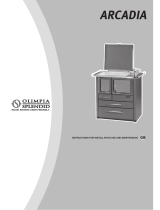13
FRANÇAIS
1. 2 Flue pipe connection
Flue pipes are a particular hazard source in
respect of escape of poisonous gas and fire
hazard. Obtain the advice of an appointed
specialist company in respect of laying and
fitting the pipes. When connecting the flue
pipe to the chimney, in the area of walls
cladded using wood, please follow the rele-
vant fitting directives.
1.3
You must follow the flue gas formation in
the event of unfavourable weather (atmos-
pheric inversion) and the draught condi-
tions. If too little combustion air is added
smoke can enter your house or flue gases
can escape. Additionally harmful deposits
can arise in the fire and in the chimney.
In the event that flue gas escapes let the
fire go out and check if all air inlet openings
are free and the flue gas feeds and the fire
pipe are clean. In cases of doubt you must
inform the master chimney sweep, as a
fault in the draught could be due to the
chimney.
1.4
Before adding new fuel, push the embers
together. .
1.5
Only use a suitable tool from our accessory
range for pushing the embers together, and
ensure that no combustible material falls
out of the fire.
1.6
Use the devices supplied with your fire,
such as the protective gloves or the cold
hand to open the doors, as well as for ope-
rating the control elements.
1.7
Design 1 fir
es (BA 1):
These fires must only be operated with the
fire door closed.
1.8
The fire door must only be opened for
adding fuel and must then be closed again,
as this could otherwise lead to a danger to
other fires that are also connected to the
chimney.
1.8.1
When the fire is not in operation, the fire
door must be kept closed.
1.9
When using wet fuel and if operation is
throttled too much, the chimney can soot
up, i.e. easily combustible materials such as
soot and tar can be deposited and this can
lead to a chimney fire.
Should this happen, close all air inlet slides
and flaps. Call the fire brigade and get your-
self and all other occupants to safety.
ATTENTION: The size of the fire door means
that, particularly when reheating blazing fla-
mes, the door must not be opened abruptly,
in order to prevent the flames from springing
out.




















